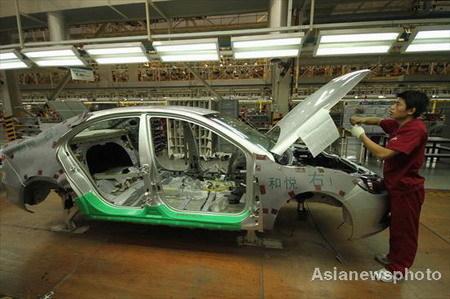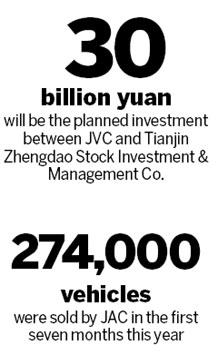
Inside a JAC plant in Hefei, Anhui province. One of China's leading truck makers, it produced its first passenger car in 2008 - a move analysts said was to prevent consolidation with Chery, also based in the province. [Hu Weiguo / For China Daily]
Plans 50-50 joint venture with controversial former head of Brilliance Auto
BEIJING - Domestic truck maker Jianghuai Automobile Co (JAC) announced last week that it will produce new-energy vehicles in a 30 billion yuan ($4.41 billion) joint venture with a foreign-funded company, the latest Chinese automaker to make a foray into clean vehicles.
According a recent JAC statement filed with the Shanghai Stock Exchange, the company signed a framework agreement on Aug 9 with Tianjin Zhengdao Stock Investment & Management Co to establish a 50-50 joint venture at JAC's home base in Hefei, capital of Anhui province, with a registered capital of 700 million yuan.

Total investment in the partnership will be around 30 billion yuan, with an annual capacity of 1 million vehicles, 1 million powertrains and 12 million kWh of lithium-ion batteries in the next eight years, the statement said.
With new-energy vehicle development now one of the hottest topics in China's motoring industry, the news received wide attention.
China's Ministry of Industry and Information Technology just completed a draft plan for the development of energy-saving and new-energy vehicles that calls for the central government to offer more than 100 billion yuan to support the sector over the next decade and to foster three to five key new-energy vehicle manufacturers, said recent Chinese-language media reports.
JAC is among the many automakers in China eyeing the huge potential government investment, analysts said.
Industry insiders also believe the JAC deal is an effort to protect itself from a merger with Chery, the largest automaker in Anhui province.
The Anhui provincial government reportedly wants to form an even-larger auto group by consolidating Chery and JAC as each has advantages. Chery is China's largest auto exporter and among the top 10 in domestic sales, while JAC is a leading truck maker.
Unwilling to merge with Chery, JAC started making passenger cars several years ago, including its first sedan introduced in 2008.
The company, founded in 1964, leads the light-duty truck segment as well as the bus chassis sector. It was listed on the Shanghai Stock Exchange in 2001.
The other partner in the potential new joint venture - Tianjin Zhengdao - also makes the story compelling.
A subsidiary of Hong Kong-listed Hybrid Kinetic Group Ltd - previously called Far East Golden Resource Group Ltd - it is run by Yang Rong, former chairman of Brilliance China Automotive Holdings Ltd, which is now the Chinese partner of BMW.
China's Third-richest
Yang led Brilliance China as it became the first mainland enterprise to go public overseas - it was listed on the New York Stock Exchange in 1992. He was named China's third-richest man in 2001 by Forbes magazine.
But Yang fled to the United States in 2002 after he was charged with alleged economic crimes by the Liaoning provincial government.
Last year Yang announced plans to again build cars, this time in both the US and China.
Hybrid Kinetic Motors (HK Motors), the auto arm of the Hybrid Kinetic Group Ltd, has selected Alabama as its first production site to make hybrid vehicles.
Yang's blueprint includes 60 billion yuan for three vehicle and engine production centers in China, according to previous media reports.
His company has been seeking local partners in several places. JAC became its first domestic partner, a necessity to secure a license to build cars in China.
JAC is a good partner with strong capability and experience in auto manufacturing, said independent analyst Zhong Shi.
The company sold about 274,000 vehicles - mostly trucks and bus components - in the first seven months this year, a surge of 60 percent from a year earlier. It moved 310,000 vehicles in all of 2009.
Major Benefit
The major benefit for JAC is cash, analysts said.
JAC made significant investment in its passenger car business that will take some time to recoup, while HK Motors has advantages in managing capital, said Zeng Zhiling, an independent automotive analyst based in Shanghai.
JAC's sedan business is estimated to remain in the red this year and become profitable in 2011, according to a report by Huatai United Securities.
JAC would prefer to have partners to share the high risk of investment in developing new-energy vehicles, Zeng said.
While the race is on to develop various forms of new, low and hybrid energy vehicles, serious questions remain whether many technologies are ready for commercial production, according to analysts.
Reports by Industrial Securities and Nanjing Securities said the innovative technology needed will be brought in by Hybrid Kinetic Group and its motor unit, yet other analysts note the group's expertise is in capital management, not the mature technology needed to mass produce clean vehicles.
The partnership will need support in innovation as the current technology of HK Motors cannot meet the planned objectives, Yao Hongguang, an analyst with Huatai United Securities said in a recent report.
Zeng agreed that the joint venture would have to seek a third party from which it can buy or co-develop green vehicle technologies.
JAC's statement did not specify what kind of new-energy vehicle the joint venture plans to make.
According to Yang's plan, the automobiles his company will produce in the US are multi-fuel hybrid models running on natural gas, batteries and gasoline.
HK Motors last year signed a $250 million contract with FEV, a German engine and powertrain system design and development firm, which will develop an engine for HK Motors primarily powered by natural gas.
The technology will be ready next year, and the prototype will debut at a major auto show in 2012, previous reports said, quoting a source from HK Motors.





